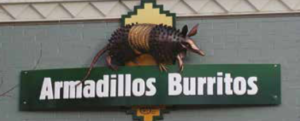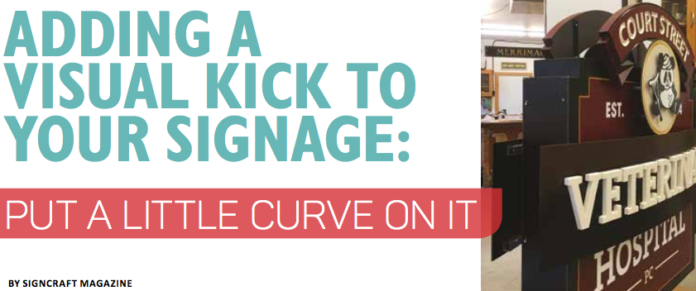You see a lot of flat signs, and you see a fair amount of 3D signs with flat layers — but you don’t see very many signs with curved panels or curved faces. It’s a great-looking effect Peter Poanessa from Keene Signworx in New Hampshire uses very successfully to add extra visual kick to an already appealing layout. This article appears in Sign Africa Journal.

‘Most signs are flat,’ said Poanessa, ‘so a curved face is immediately unique and interesting to the viewer. When you couple that with other dimensional elements, you can create something that is really appealing to look at. And that’s the critical task of a creative sign.’
There’s a little engineering involved, of course. Today’s materials and assembly methods, though, make curved faces easier. At first, Poanessa made curved faces using ‘cold forming’. He built a form, then laminated layers of material over it. Once the glue dried and the material was taken off the form, it kept that shape. He often used this approach to form SignFoam high density urethane board over two layers of 6mm (1⁄4 inch) plywood using epoxy to laminate it. He also did a few by cutting curved PVC supports and laminating the HDU board over that.

‘As time went on,’ he said, ‘I moved towards using a curved thin-wall tubular aluminium frame with aluminium composite material over it. I bond the face to the frame with Lord adhesive, which chemically welds it to the frame. It’s very strong.

‘I now have a Baliegh R-M7 radius manual tubing bender. I run the aluminium tubing through it and get nice consistent long arcs. It’s a fairly inexpensive tool that uses a hand crank to feed the tubing between rollers to bend it. Once I have the tubing bent into the arc that I want, I just laminate the aluminium composite material over it. It’s super rigid and super strong.’

The Veterinary panel uses cut-out letters on a curved aluminium composite panel with LEDs behind it. The ‘wood’ on the base of the pylon is a synthetic decking material from the local lumber yard, which comes in a wide range of beautiful colours.




Simplifying the production method makes creating curved sign faces a practical option. Whether it’s a simple curved panel that carries all or part of the primary copy or the entire sign face is curved, the added dimension and drama make it another tool in the sign designer’s bag of tricks.
Submit your news and video content to journo@practicalpublishing.co.za
Subscribe to our YouTube channel, read the top 5 stories weekly on WhatsApp or sign up to our newsletter.
This article was republished with the permission of SignCraft magazine.















